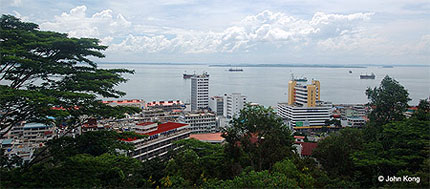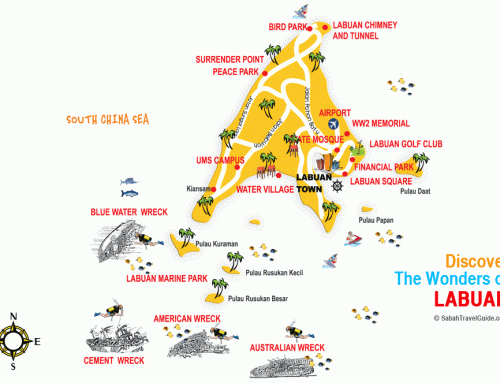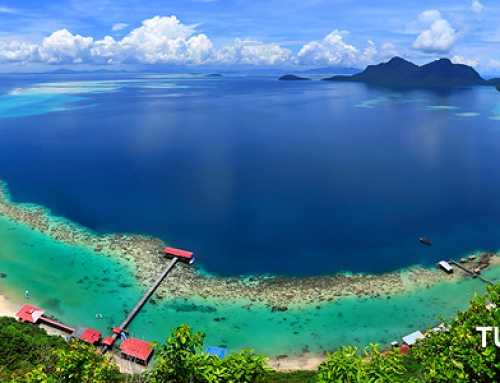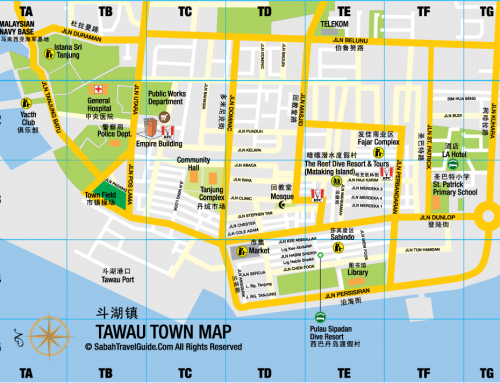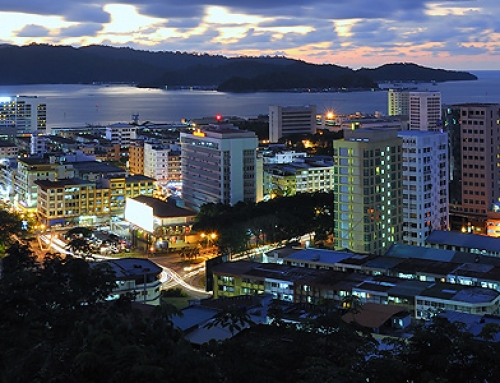Sandakan is a captivating town with its very own charm, friendly people and fabulous places to devour seafood. It has its own intriguing history and roots tracing back to the early 1870s. Located on the northeast coast of Sabah, looking out to the Sulu Sea, Sandakan is a postwar town where much of it was rebuilt on reclaimed land and is Malaysia’s biggest fishing port. Sandakan is often nicknamed “Mini Hong Kong” due to its Cantonese influence whereby its occupants are well-heeled and the town sustains many booming businesses.
It was the former capital of British North Borneo from the years 1884-1946. Sandakan was one of the largest towns in Sabah in the early years with traders from Europe to Africa, from Arabia to China, from the Indies to Java and from local Dusuns to the Japanese. After WWII the capital was transferred to Jesselton (now Kota Kinabalu). Sandakan was rebuilt and became Sabah’s first and foremost port for timber export. This district was said to have the biggest concentration of millionaires in the world due to timber export which naturally leading an influx of people from all around the world. However, due to the fast dwindling supply of tropical timber and most natural resources depleting, reminders surfaced for the protection of plants and animals
In the early years, this district served as a major port for early settlers to Sabah, and most Chinese came through this port. With the many Chinese from Canton, Sandakan once earned the nick-name of “Little Hong Kong”.
Places of interest in Sandakan include:-
- the Puu Jih Shih Chinese Temple – a majestic temple erected on top of a hill facing Sandakan Bay
- St Michael and All Angels Cathedral, erected in the late 19th century and one of the oldest stone buildings in Sabah.
- the world-famous Sepilok Orang Utan Rehabilitation Centre which is located just 26 km from Sandakan.
- The Sandakan Crocodile Farm located on the Labuk Road near Sepilok and Labuk Bay Proboscis Monkey Sanctuary is also major attractions for day trips.
Sandakan is the main take-off point to the major wildlife destinations on the east coast such as the Kinabatangan River (Sukau, Bilit and Gomantong Caves) and Turtle Islands where you get to observe wildlife in their natural habitat. You can also continue overland and south of Sandakan to the Tabin Wildlife Reserve and Danum Valley.
HISTORY
A captivating town with its very own charm, friendly people, and many fabulous places to eat seafood. Sandakan has also its own intriguing history and traces its roots back to the early 1870s, when William Clarke Cowie, a Scottish adventurer, and engineer was trading guns and ammunition with the Sultan of Sulu so that he could protect his territories from the Spanish. In return, the Sultan granted Cowie permission to settle on Pulau Timbang in the Sandakan Bay, where there was a small Suluk village. Cowie called his base Sandakan, deriving the word from Suluk “sanda” and the suffix “kan”, and Sandakan translates roughly into ‘the place that was pawned’. Cowie’s settlement soon became known as “Kampung German” because a lot of Germans called at his trading post.
In 1879 the settlement was relocated to Buli Sim-Sim, which at that time was a narrow, uninhabited coastal fringe of jungle and mangroves. However, Cowie found that the natural harbour was one of the most beautiful in the world, and he renamed his new settlement “Elopura”, meaning ‘Beautiful Town’. But eventually the name Sandakan prevailed, and in 1883 the British North Borneo Chartered Company (BNBCC) moved its capital in North Borneo from Kudat to Sandakan. The trading post developed into a striving little town, but all business came to an abrupt end when the Japanese invaded Borneo during WWII. To liberate the town Allied bombers nearly flattened Sandakan towards the end of the war, and in retaliation, the Japanese burnt whatever had survived the bombings. Sandakan virtually ceased to exist in June 1945.
After WWII, and faced with the impossibly expensive task of rebuilding Sabah, the BNBCC relinquished its rights to the British Crown, and in 1946 under colonial administration, Sabah’s capital was moved to Jesselton (now Kota Kinabalu).
Nevertheless, this district was rebuilt and became Sabah’s first and foremost port for the export of timber. Thus, after the war, Sandakan grew bigger and stronger, and prospered with revenge! During its heydays, it is said that Sandakan had the greatest concentration of millionaires in the world! This prosperity naturally led to an influx of people from all over the world, from China over India to Arabia and Europe, from Indonesia to the Philippines and even to Japan. However, the seemingly inexhaustible supply of tropical timber dwindled fast and today most natural resources are depleted, with the reminders in protected reserves for plants and animals. Sandakan developed much of the former jungle into palm plantations, but due to the jungle reserves and vast conservation areas of one of the world’s oldest rainforest, it is famous now as the gateway to Sabah’s unique and rich flora & fauna.

